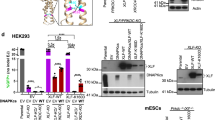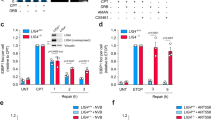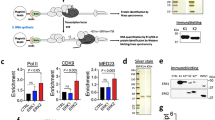Abstract
Exposure to topoisomerase II inhibitors is linked to the generation of leukemia involving translocations of the MLL gene, normally restricted to an 8.3 kbp tract, the breakpoint cluster region (BCR). Using an in vitro assay, apoptotic activators, including radiation and anti-CD95 antibody, trigger site-specific cleavage adjacent to exon 12 within the MLL BCR and promote translocation of the MLL gene in cells that can survive. To explore the mechanism of cleavage and rearrangement in more detail, the entire MLL BCR was placed into the pREP4 episomal vector and transfected into human lymphoblastoid TK6 cells. Episomes containing either the MLL BCR, or deletion constructs of 367 bp or larger, were cleaved at the same position as genomic MLL after exposure to apoptotic stimuli. Further analysis of sequence motifs surrounding the cleaved region of MLL showed the presence of both a predicted nuclear matrix attachment sequence and a potential strong binding site for topoisomerase II, flanking the site of cleavage. Inactivation of topoisomerase II by the catalytic inhibitor merbarone did not inhibit MLL cleavage, suggesting that the initial cleavage step for MLL rearrangement is not mediated by topoisomerase II.
This is a preview of subscription content, access via your institution
Access options
Subscribe to this journal
Receive 12 print issues and online access
$259.00 per year
only $21.58 per issue
Buy this article
- Purchase on Springer Link
- Instant access to full article PDF
Prices may be subject to local taxes which are calculated during checkout




Similar content being viewed by others
References
Rubnitz JE, Behm FG, Downing JR . 11q23 rearrangements in acute leukemia. Leukemia 1996; 10: 74–82.
Thandla S, Aplan PD . Molecular biology of acute lymphocytic leukemia. Semin Oncol 1997; 24: 45–56.
Canaani E, Nowell PC, Croce CM . Molecular genetics of 11q23 chromosome translocations. Adv Cancer Res 1995; 66: 213–234.
Super HJ, McCabe NR, Thirman MJ, Larson RA, Le Beau MM, Pedersen-Bjergaard J et al. Rearrangements of the MLL gene in therapy-related acute myeloid leukemia in patients previously treated with agents targeting DNA-topoisomerase II. Blood 1993; 82: 3705–3711.
Felix CA, Winick NJ, Negrini M, Bowman WP, Croce CM, Lange BJ . Common region of ALL-1 gene disrupted in epipodophyllotoxin-related secondary acute myeloid leukemia. Cancer Res 1993; 53: 2954–2956.
Felix CA . Secondary leukemias induced by topoisomerase-targeted drugs. Biochim Biophys Acta 1998; 1400: 233–255.
Stanulla M, Wang J, Chervinsky DS, Thandla S, Aplan PD . DNA cleavage within the MLL breakpoint cluster region is a specific event which occurs as part of higher-order chromatin fragmentation during the initial stages of apoptosis. Mol Cell Biol 1997; 17: 4070–4079.
Betti CJ, Villalobos MJ, Diaz MO, Vaughan AT . Apoptotic triggers initiate translocations within the MLL gene involving the nonhomologous end joining repair system. Cancer Res 2001; 61: 4550–4555.
Strissel PL, Strick R, Rowley JD, Zeleznik-Le NJ . An in vivo topoisomerase II cleavage site and a DNase I hypersensitive site colocalize near exon 9 in the MLL breakpoint cluster region. Blood 1998; 92: 3793–3803.
Betti CJ, Villalobos MJ, Diaz MO, Vaughan AT . Apoptotic stimuli initiate MLL-AF9 translocations that are transcribed in cells capable of division. Cancer Res 2003; 63: 1377–1381.
Solovyan VT, Bezvenyuk ZA, Salminen A, Austin CA, Courtney MJ . The role of topoisomerase II in the excision of DNA loop domains during apoptosis. J Biol Chem 2002; 277: 21458–21467.
Li TK, Chen AY, Yu C, Mao Y, Wang H, Liu LF . Activation of topoisomerase II-mediated excision of chromosomal DNA loops during oxidative stress. Genes Dev 1999; 13: 1553–1560.
Lagarkova MA, Iarovaia OV, Razin SV . Large-scale fragmentation of mammalian DNA in the course of apoptosis proceeds via excision of chromosomal DNA loops and their oligomers. J Biol Chem 1995; 270: 20239–20241.
Sim SP, Liu LF . Nucleolytic cleavage of the mixed lineage leukemia breakpoint cluster region during apoptosis. J Biol Chem 2001; 276: 31590–31595.
Whitmarsh RJ, Saginario C, Zhuo Y, Hilgenfeld E, Rappaport EF, Megonigal MD et al. Reciprocal DNA topoisomerase II cleavage events at 5′-TATTA-3′ sequences in MLL and AF-9 create homologous single-stranded overhangs that anneal to form der (11) and der (9) genomic breakpoint junctions in treatment-related AML without further processing. Oncogene 2003; 22: 8448–8459.
Broeker PL, Super HG, Thirman MJ, Pomykala H, Yonebayashi Y, Tanabe S et al. Distribution of 11q23 breakpoints within the MLL breakpoint cluster region in de novo acute leukemia and in treatment-related acute myeloid leukemia: correlation with scaffold attachment regions and topoisomerase II consensus binding sites. Blood 1996; 87: 1912–1922.
Slater DJ, Hilgenfeld E, Rappaport EF, Shah N, Meek RG, Williams WR et al. MLL-SEPTIN6 fusion recurs in novel translocation of chromosomes 3, X, and 11 in infant acute myelomonocytic leukaemia and in t(X;11) in infant acute myeloid leukaemia, and MLL genomic breakpoint in complex MLL-SEPTIN6 rearrangement is a DNA topoisomerase II cleavage site. Oncogene 2002; 21: 4706–4714.
Villalobos MJ, Betti CJ, Vaughan AT . Detection of DNA double-strand breaks and chromosome translocations using ligation-mediated PCR and inverse PCR. Methods Mol Biol 2004; 291: 279–290.
Staley K, Blaschke AJ, Chun J . Apoptotic DNA fragmentation is detected by a semi-quantitative ligation-mediated PCR of blunt DNA ends. Cell Death Differ 1997; 4: 66–75.
Schlissel MS . Structure of nonhairpin coding-end DNA breaks in cells undergoing V(D)J recombination. Mol Cell Biol 1998; 18: 2029–2037.
Gu Y, Alder H, Nakamura T, Schichman SA, Prasad R, Canaani O et al. Sequence analysis of the breakpoint cluster region in the ALL-1 gene involved in acute leukemia. Cancer Res 1994; 54: 2326–2330.
Bode J, Kohwi Y, Dickinson L, Joh T, Klehr D, Mielke C et al. Biological significance of unwinding capability of nuclear matrix-associating DNAs. Science 1992; 255: 195–197.
Nagata S, Nagase H, Kawane K, Mukae N, Fukuyama H . Degradation of chromosomal DNA during apoptosis. Cell Death Differ 2003; 10: 108–116.
Arnoult D, Gaume B, Karbowski M, Sharpe JC, Cecconi F, Youle RJ . Mitochondrial release of AIF and EndoG requires caspase activation downstream of Bax/Bak-mediated permeabilization. EMBO J 2003; 22: 4385–4399.
Janicke RU, Sprengart ML, Wati MR, Porter AG . Caspase-3 is required for DNA fragmentation and morphological changes associated with apoptosis. J Biol Chem 1998; 273: 9357–9360.
Langer T, Metzler M, Reinhardt D, Viehmann S, Borkhardt A, Reichel M et al. Analysis of t(9;11) chromosomal breakpoint sequences in childhood acute leukemia: almost identical MLL breakpoints in therapy-related AML after treatment without etoposides. Genes Chromosomes Cancer 2003; 36: 393–401.
Gillert E, Leis T, Repp R, Reichel M, Hosch A, Breitenlohner I et al. DNA damage repair mechanism is involved in the origin of chromosomal translocations t(4;11) in primary leukemic cells. Oncogene 1999; 18: 4663–4671.
Stanulla M, Chhalliyil P, Wang J, Jani-Sait SN, Aplan PD . Mechanisms of MLL gene rearrangement: site-specific DNA cleavage within the breakpoint cluster region is independent of chromosomal context. Hum Mol Genet 2001; 10: 2481–2491.
Spitzner JR, Muller MT . A consensus sequence for cleavage by vertebrate DNA topoisomerase II. Nucleic Acids Res 1988; 16: 5533–5556.
Fortune JM, Osheroff N . Merbarone inhibits the catalytic activity of human topoisomerase IIalpha by blocking DNA cleavage. J Biol Chem 1998; 273: 17643–17650.
Vologodskii AV, Zhang W, Rybenkov VV, Podtelezhnikov AA, Subramanian D, Griffith JD et al. Mechanism of topology simplification by type II DNA topoisomerases. Proc Natl Acad Sci USA 2001; 98: 3045–3049.
Acknowledgements
This work was supported by a Merit Grant from the Veterans Administration to ATMV, NIH CA102197 and the Wolf family.
Author information
Authors and Affiliations
Corresponding author
Rights and permissions
About this article
Cite this article
Betti, C., Villalobos, M., Jiang, Q. et al. Cleavage of the MLL gene by activators of apoptosis is independent of topoisomerase II activity. Leukemia 19, 2289–2295 (2005). https://doi.org/10.1038/sj.leu.2403966
Received:
Accepted:
Published:
Issue Date:
DOI: https://doi.org/10.1038/sj.leu.2403966
Keywords
This article is cited by
-
Topoisomerase-mediated chromosomal break repair: an emerging player in many games
Nature Reviews Cancer (2015)
-
Transcription linked to recombination: a gene-internal promoter coincides with the recombination hot spot II of the human MLL gene
Oncogene (2007)
-
MLL rearrangements emerge during spontaneous apoptosis of clinical blood samples
Leukemia (2006)



